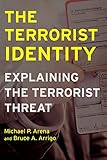The Terrorist Identity : Explaining the Terrorist Threat / Bruce A. Arrigo, Michael P. Arena.
Material type: TextSeries: Alternative Criminology ; 5Publisher: New York, NY : New York University Press, [2006]Copyright date: ©2006Description: 1 online resourceContent type:
TextSeries: Alternative Criminology ; 5Publisher: New York, NY : New York University Press, [2006]Copyright date: ©2006Description: 1 online resourceContent type: - 9780814707159
- 9780814707814
- 363.325
- online - DeGruyter
| Item type | Current library | Call number | URL | Status | Notes | Barcode | |
|---|---|---|---|---|---|---|---|
 eBook
eBook
|
Biblioteca "Angelicum" Pont. Univ. S.Tommaso d'Aquino Nuvola online | online - DeGruyter (Browse shelf(Opens below)) | Online access | Not for loan (Accesso limitato) | Accesso per gli utenti autorizzati / Access for authorized users | (dgr)9780814707814 |
Frontmatter -- Contents -- Acknowledgments -- Part I -- 1 Introduction -- 2 The Psychology of Terrorism -- 3 The Sociology of Identity -- Part II -- 4 An Overview of Five Extremist Organizations -- 5 The Provisional Irish Republican Army -- 6 The Islamic Resistance Movement (Hamas) -- 7 The Peruvian Shining Path -- 8 The Liberation Tigers of Tamil Eelam -- 9 Racist Skinheads -- Part III -- 10 Conclusion -- Notes -- References -- Index -- About the Authors
restricted access online access with authorization star
http://purl.org/coar/access_right/c_16ec
Who would strap a bomb to his chest, walk into a crowded subway station and blow himself up? Only by examining how a terrorist understands his own identity and actions can this question be answered. The authors of The Terrorist Identity explore how the notion of self-concept combined with membership in terrorist and extremist groups, can shape and sustain the identity of a terrorist as well as their subsequent justification for violence and the legitimacy of their actions.The book provides an understanding of identity that draws on concepts from psychology, criminology, and sociology. Notably, the book examines several case studies of various terrorist groups, including: the Provisional Irish Republican Army, Hamas, the Shining Path, the Liberation Tigers of Tamil Eelam, and racist Skinheads. By making the construct of identity central to this analysis The Terrorist Identity explains how violent and extremist collective behavior emerges culturally, how it informs the identity of group members socially, and how participants assume their place in these groups completely even at the expense of life-threatening harm to others or to themselves.
Mode of access: Internet via World Wide Web.
In English.
Description based on online resource; title from PDF title page (publisher's Web site, viewed 06. Mrz 2024)


